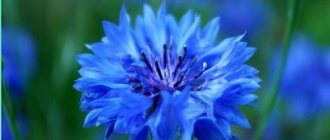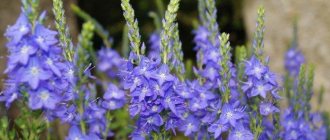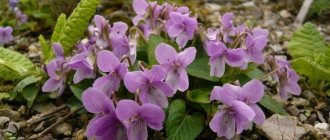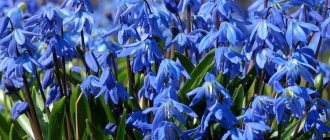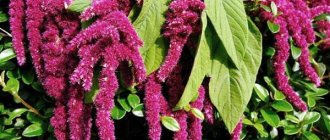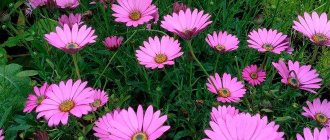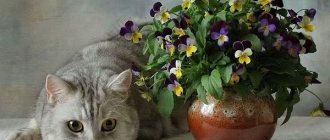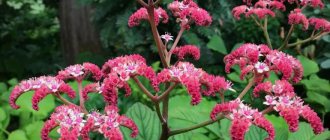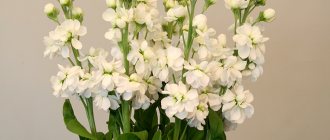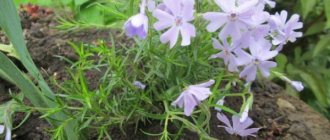Oh, cornflowers, cornflowers, how many of you flash in the field... Cornflowers are field plants, loved by many.
It is not for nothing that in Russian this flower is given such a tender and affectionate name - cornflower. There are songs about him, and poems... A bouquet of cornflowersCornflowers are found in meadows among multi-colored herbs; open spaces with blue cornflowers and red poppies look especially beautiful. They also grow in fields, especially often found among rye crops, now as weeds, but even here their blue heads sway so beautifully among the golden ears.
All this has been said about the most familiar species to us - blue cornflower, an annual plant known to everyone. But its genus is very extensive: almost 500 species of different cornflowers grow in nature.
Pink cornflower Cornflowers, cornflowers, blue flowers - this is what this plant is called in different parts of our country. Let's get to know each other better. Cornflower (Centaurea) is a genus of plants in the Asteraceae family. Found almost everywhere in the northern hemisphere. It is believed that its Latin name comes from the Greek word kentaurion, which means Chiron: this was the name of the famous centaur from ancient Greek myths, the teacher of the famous Hercules and a healer who knew medicinal herbs and their properties.
Ads by
More about the plant
All cornflowers are herbaceous plants, usually having straight, rather tall, branched stems, but there are also plants with recumbent shoots.
Their leaves can be simple or dissected. Cornflower flower Cornflowers have a basket-shaped inflorescence consisting of funnel-shaped flowers of various colors. They are located along the edge, and in the middle, as usual in all Asteraceae, the flowers are tubular.
Features of different types
It is interesting that different types of cornflowers have different root systems.
Some have a long rhizome with branches, for example, soft cornflower. Others produce many root shoots - this is c. Fisher. Still others have a tap root, going deep, like v. Russian. Some species have powerful thick rhizomes. Perennial cornflowers have one more feature - their basal leaves remain green all year round. They grow in 2 periods: in the spring, young leaves appear, which live until the end of summer, and in September-October, others grow and remain until the next spring. The leaves of all species are beautiful, feathery, often pubescent so that they appear silvery. Cornflowers can be considered wonderful plants that add unique beauty to flower beds throughout the season. Meadow cornflowers
And when they are in bloom, they are especially elegant. In addition, their flowering usually lasts quite a long time, from about the end of June to the beginning of August, that is, about 45 days.
Groups of cornflowers
The diversity of the structure of the root system is important for gardeners, since it is by this type that garden cornflowers can be divided into 2 main groups:
- Plants with a long root or shortened rhizome. This is Russian cornflower, whitened, meadow, Marshall, large-headed. These species form fairly dense bushes that grow slowly and reproduce only with the help of seeds.
- Another group is represented by plants in which the rhizome is located horizontally or has root suckers. With their help, they easily grow and reproduce vegetatively. This is a soft, mountain, Fischer cornflower.
We invite you to our market for cornflower seeds.
There you will probably choose exactly the plant that is best suited for your site. Cornflower Sister Alyonushka, Mixture, 0.3 g 32 rub.
seedspost.ru
Cornflower Border, Mixture, 0.2 g 32 rub.
seedspost.ru
Cornflower Brother Ivanushka, Mixture, 0.3 g 32 rub.
seedspost.ru
Cornflower Cherry crown, 0.2 g 32 rub.
seedspost.ru
general information
Cornflowers are found throughout Europe, decorating lawns and flower beds in gardens and cities. They also grow in the wild, where our distant ancestors noticed it and began to use it as a medicinal plant.
The bright flowers of cornflower are large inflorescences-baskets of individual small flowers that look like petals. In addition to blue and dark blue varieties, there are white, pink, yellow and burgundy varieties.
Cornflower is a herbaceous plant, but it is not always small, because some species can grow over a meter. Among them there are annuals and perennials, and in natural conditions they grow almost like weeds.
Basically, the stems of cornflowers are erect or recumbent, and the leaves can be whole or heavily dissected. The inflorescences are collected in several pieces, due to which wonderful bouquets are obtained from cornflowers. Otherwise, it is quite problematic to derive a single general description due to the diversity of the genus.
Photo: phonoteka.org
Brief description of the flower
Cornflower from the Asteraceae (Asteraceae) family belongs to herbaceous plants. Includes several species, most of which originate in Southern Europe. Today it is widespread throughout Europe and most often grows as a weed on plantings of grain crops, primarily rye. Most of the species are found in Russia, and some of them are included in the Red Book. These include:
- cornflower;
- Dubyansky's cornflower;
- Taliev's cornflower.
Perennial cornflower
Externally, perennial cornflower is a beautiful plant, the shoots of which can be recumbent or erect, depending on the structure. Their height can reach 120 cm. The foliage is arranged alternately, the shape varies from whole to variegated-dissected. Inflorescences are presented in the form of baskets of various shapes: from the usual spherical to cylindrical. The scale involucres are either bare or pubescent. They are arranged in several pieces or arranged one at a time in paniculate and corymbose inflorescences. Along the edges are flowers in the shape of a funnel, most often tubular. Their color in most cases is blue or dark blue, but there are other options:
- white;
- pink;
- burgundy;
- yellow;
- purple;
- red;
- blue.
The root system of different species is also very different and can be presented in the following forms:
- formed due to the numerous number of root shoots;
- with a powerful and recessed root core;
- with oblong branched rhizomes;
- with a shortened, strongly branching root that forms a curtain;
- with a powerful and thickened spine.
Powerful stems
This plant can be grown for cultural purposes due to its beauty. They are often planted near schools and kindergartens to saturate the areas with greenery and bright inflorescences. They go well with daisies and bluebells. The beneficial value of the cornflower flower is very high due to the fact that it is a honey plant that can attract pollinating insects to a flower bed or orchard.
Cornflowers have a therapeutic diuretic effect, which leads to the use of folk remedies based on them for the treatment of kidney diseases. The petals of the plant are rich in other medicinal properties. Due to their powerful aroma, flowers can be used in cooking as a seasoning, as well as for cosmetic purposes.
Types of cornflowers
In Russia alone there are about 180 species that belong to the genus of cornflowers. In fact, there are many more, but we'll start with the main ones!
Blue cornflower
The most popular and widespread in our latitudes. It is grown as an annual, and less often as a biennial plant. Erect stems, silvery leaves and single basket-shaped inflorescences are blue cornflower.
Photo: 2sotki.ru
Pink cornflower
And again the name speaks for itself, so its peculiarity is single pink inflorescences about 5 cm in diameter. The leaves and shoots of pink cornflowers are slightly lighter.
Photo: flo.discus-club.ru
Field cornflower
An herbaceous annual with delicate blue-blue heads that bloom in late spring. It is often planted in flower beds in group compositions.
Photo: youtube.com
Meadow cornflower
A perennial herbaceous species with stiff, straight, tall stems. The inflorescences of such cornflowers are usually white or pinkish, and the leaves and shoots seem to be covered with a silvery coating.
Photo: etnomagazin.ru
Large-headed cornflower
One of the tallest species, up to 120 cm in height and with large yellow inflorescences up to 7 cm in diameter. Large-headed cornflower blooms by mid-summer.
Photo: dachnaya-zhizn.ru
White cornflower
It is distinguished not only by its white color, but also by its voluminous double inflorescences, approximately 4 cm in diameter. But this species is listed in the Red Book throughout Europe.
Photo: sady-msk.ru
Levkoy (50 photos): types, care and planting in open ground
Cornflower blue description
Cornflower Cornflower is a magnificent representative of the Asteraceae family, which can become i..., found among meadow grasses, belongs to the representatives of the Asteraceae, a group of Asteraceae. In common people, the plant was called blue flower, rye flower, hairy flower, and blue flower. Thanks to its rapid growth rate and unpretentiousness, cornflowerCornflower is a magnificent representative of the Asteraceae family, which can become i... settled far beyond the borders of its homeland.
Among the cornflower variety there are perennial and annual varieties. Perennial plants withstand bad weather, cold, and drought more steadfastly; flowers of this type grow quickly, get along with all types of plants and sometimes some survive from the site.
Cornflower Cornflower is a magnificent representative of the Asteraceae family, which can become an i... blue one, is little susceptible to disease, reproduces without problems, blooms for a long time, and therefore is so loved by gardeners. Throughout the growing season, the leaves of cornflowerCornflower is a magnificent representative of the Asteraceae family, which can become i... remain green, in the fall, with proper care, the plant can turn green again, and even delight you with flowers.
The stem of the plant is thin, erect, and prone to lodging, like all meadow plants. Flowering is long, the first from May to June, and with proper care, it blooms again in August, with bright blue flowers.
After flowering, it forms a small seed box, which must be removed in time to avoid the flower turning into an annoying weed.
It is customary to cut the seed pod until it cracks; if necessary, the seeds are removed and dried.
Blue cornflowerCornflower is a magnificent representative of the Asteraceae family, which can become an... often found as a weed in fields sown with rye. Cultivated rye is an annual (biennial) herbaceous plant of the Evil family..., thanks to the long and strong root system, the flower grows quite long and is capable of endure any weather changes.
Growing quickly, it can completely clog a cereal crop, so the plant is an undesirable guest in the fields.
Shades of cornflowerCornflower is a magnificent representative of the Asteraceae family, which can become i... blue varies from dark blue to purple, the stem of the plant is thin but long, reaching a meter in height. The plant bears fruit with asteraceous fruits, a tufted oblong achene, and oval shape.
Composition of cornflower flowersCornflower is a magnificent representative of the Asteraceae family, which can become i... includes a glycoside, cyanogenic and pigment, these substances are mildly toxic, therefore, when using the plant for medicinal purposes, you must clearly know the dosage and its contraindications.
The rich color of cornflowerCornflower is a magnificent representative of the Asteraceae family, which can become an id... received due to the presence of anthocyanin in the composition, this element has antioxidant properties.
In addition to the above, cornflowerCornflower is a magnificent representative of the Asteraceae family, which can become i... blue is rich in organic acids, resins, alkaloids, tannins, B vitamins, retinol, esters, phenols and flavones.
Caring for cornflowers
If you choose the right area for cornflowers, even an inexperienced beginner can easily handle the care. Despite all its visual fragility, the plant causes almost no trouble!
Temperature and lighting
Cornflowers are heat-loving, so they need a warm and bright area without drafts. It is important that they do not shade themselves, so when planting, leave 15-50 cm between the bushes, depending on the size of the variety.
Photo: 2sotki.ru
Watering
Cornflowers do not tolerate stagnation of water in the soil very well, so you should not flood them. They will grow poorly in areas with close groundwater. Additional moderate watering is needed only in the absence of rain for a long time.
Photo: zen.yandex.ru
The soil
The ideal soil for cornflowers is light loam. You also need to get rid of excessive acidity, so add lime to the soil as needed in the fall. Sawdust or sand are suitable as a baking powder.
Photo: oir.mobi
Fertilizers and fertilizing
Cornflowers need fertilizing mainly to extend the flowering period, so pay attention to potassium-phosphorus mixtures. It is enough to use complex preparations once every 2-3 weeks when watering.
Photo: cvetyportal.ru
Trimming
Cornflowers grow strongly and actively reproduce by self-sowing, so the plantings need to be thinned and trimmed periodically. There are two types of pruning - low and high. When low, no more than 10 cm of shoots remain, and in the end this has a great effect on the aesthetics of the flower bed. When tall, the stems are shortened just before the inflorescences, and this method is better for beginners.
Photo: flosium.ru
Wintering
Perennial varieties easily overwinter in open ground in the middle zone and even further north. Most of them do not require shelter and do not cause problems at all. It is enough to trim the bushes short before winter.
Photo: oir.mobi
Loosestrife (50 photos): types, planting and care in open ground
Cornflower flower
Cornflower is a herbaceous annual or perennial with delicate flowers. The plant belongs to the Asteraceae family. The scientific name, centaurea, has been variously interpreted as “centaur flower” or “ox-stabbing.” It is known to almost everyone due to its wide distribution and impressive number of wild varieties.
Although the plant's homeland is Southern Europe, it can be found everywhere in temperate climates: in fields, in steppes. Cornflower is used in a variety of ways. They decorate the garden and are also used in medicine and cooking. In Rus', the plant was considered a powerful amulet against evil spells and was used by girls in rituals on the holiday of Ivan Kupala.
Cornflower is a flowering plant with a developed horizontal rhizome and herbaceous stems. Erect, slightly branched shoots grow 50-80 cm in height. They are covered with short, hard pile and colored green. The linear-lanceolate leaves of small size differ even on the same plant. The lower ones are larger, lobed, and the upper ones are narrow, solid.
Small inflorescences-baskets are formed at the top of the stems. They begin to bloom in June and replace each other until the autumn cold. Inflorescences can be simple or double. They consist of bisexual tubular flowers in the center and sterile reed flowers closer to the edge. Narrow, carved petals are arranged in 1-2 rows or evenly throughout the entire inflorescence. Their color can be yellow, blue, white, pink, blue, purple or burgundy.
Cornflowers are good honey plants. Each flower can release up to 6 portions of pollen. After pollination, dry multi-seeded capsules about 5 mm long ripen. In the upper part there is a silver-gray crest. Seeds ripen between July and October.
The cornflower genus is very diverse.
It includes more than 700 plant species. Some of them have an uncertain status or are recognized as synonyms of other species, but the remaining varieties are more than enough to decorate the garden. Meadow cornflower
Meadow cornflower. Perennial flowering herbs can grow up to 1 m in height. They have a powerful vertical rhizome and erect stems with a rough surface. Branching occurs mainly in the upper part. The elongated lanceolate leaves with a rough surface are dark green in color with a silvery coating. At the beginning of summer, fluffy baskets bloom. The calyx is scaly and yellow. Lilac-pink narrow petals peek out from the top. Tubular flowers are concentrated in the center.
Rough cornflower
Rough cornflower. The herbaceous perennial has erect or ascending stems with edges.
The height of the plant is 0.4-1.2 m. The cut leaves are painted dark green. At the base of the stem they grow on petioles, and at the top they sit on it. Single baskets with an ovoid brownish calyx bear lilac-purple or pink flowers. Flowering occurs in June-September. Mountain cornflower
Mountain cornflower. The plants have a powerful horizontal rhizome and an erect, unbranched stem.
Its height is 60 cm. The leaves are linear-lanceolate, bright green. Flowers - single baskets up to 6 cm in diameter consist of blue-violet reed flowers along the edge and short tubular flowers in the center. The variety blooms all summer. Blue cornflower
Blue cornflower. An annual or biennial with a rough, erect stem 15-100 cm in height.
The rhizome is thin, rod-shaped. The shoot is branched in the upper part and covered with lanceolate, notched foliage with short felt pile. A crown-shaped basket blooms with lilac-blue flowers. Below is an ovoid greenish-brown calyx. The same species is called field cornflower or cornflower. Its seeds are often mixed with cereals and contaminate crops, so in agriculture the plant is considered a weed and difficult to eradicate. Garden cornflower
Garden cornflower. An annual or perennial ornamental plant up to 120 cm high, it blooms beautiful large baskets with pink, bright blue, light blue or burgundy petals. Its flowering is long and abundant. A very popular varietal group is “terry cornflower”. It has spherical bright heads, in which reed flowers are located, including in the center. The petals are corrugated and serrated. Varieties: Blue Boy - dark blue baskets bloom on shoots 50-90 cm in height; Red Boy - blooms with ruby red flowers; Schneemann - a plant 70-80 cm high blooms snow-white double flowers.
Annual and perennial cornflowers are convenient to grow from seeds. Sowing is done immediately in open ground or in containers (if you plan to decorate the balcony and veranda). In mid-April, the soil is prepared for planting: it is dug up and loosened. The soil should be non-acidic. It is believed that cornflowers grow better on calcareous soils and the color of the petals is brighter. Seeds remain viable for up to 3 years.
They are sown without pre-treatment in holes 2-3 cm deep. Try to distribute them evenly, not densely. Shoots appear after 2 weeks. As they grow, they are thinned out. First, leave a distance of 20 cm, and then for tall varieties increase it to 50 cm. You can sow the seeds in October-November, then in the spring the seedlings will appear earlier and, accordingly, flowering will begin earlier.
Some gardeners grow seedlings. Seeds should be immediately distributed into peat pots, as the root system is easily damaged. Before planting in open ground, it is kept at a temperature of +18°C.
Perennial cornflowers can be propagated by dividing the rhizomes. At the end of the flowering period (August), a strong bush is dug up and completely freed from the earthen clod. The roots are washed in warm water. The stems are trimmed to a height of 10 cm. The rhizome is divided into segments using a knife or shovel. You can simply break it into pieces with your hands. Each division must have at least 3 buds. Immediately after the manipulation, the plants are planted in a new place.
Cornflowers are planted in a well-lit, open place. Slight shading is allowed. The soil should be light and loose. Loams or sandy loams are suitable. If necessary, add sand to heavy soils.
Daily care is very easy. It comes down to infrequent watering, only in the absence of precipitation. Cornflowers tolerate drought well, but they suffer greatly from stagnation of water in the soil.
Once or twice a month, plants are fed with a mineral complex (20-30 g/m²). Well-diluted fertilizer is poured into the soil at the roots. If you apply too much fertilizer, the foliage will begin to turn yellow and dry out.
In order for the vegetation to have an attractive appearance, faded flowers should be removed in a timely manner. You can limit yourself to removing only the inflorescence itself and leaving the shoot intact, but it is better to cut it to a height of 10 cm above the ground. Then the growth will be more neat and dense.
Plants do not need shelter for the winter. Annuals are simply cut and dug up in the area. And perennials are cut back to the ground. The remaining shoots will dry out, and in the spring new shoots will sprout from the roots.
Cornflower gets sick very rarely. This can happen if the location is too shady and damp. Then fusarium develops on the shoots. Treatment with a fungicide will help correct the situation, but it is better to carefully follow agricultural practices. At high temperatures and dry air, cornflowers can be attacked by spider mites. Get rid of parasites using a solution of soap or insecticides.
Dense and at the same time airy growth of cornflowers, decorated with bright multi-colored heads, is used to design mixed flower beds, mixborders, balconies and terraces. Flowers can be used in group plantings, combining different varieties, or combined with plants such as cereals, daisies, forget-me-nots, poppies, calendula, and marigolds.
The plant is used in folk medicine and pharmaceuticals. Cornflower flowers contain large amounts of: mineral salts; vitamins; tannins; alkaloids; glycosides; flavonoids.
The procurement of raw materials is carried out during the flowering period. Only fresh, unwilted inflorescences are used. They are thoroughly dried in a dark, ventilated place and stored in an airtight container.
Water and alcohol infusions, decoctions or teas are prepared from the resulting raw materials. The drugs have diaphoretic, antipyretic, diuretic, antimicrobial, choleretic, laxative, analgesic, and antispasmodic effects on the body.
Cornflower is taken orally for gastrointestinal upset, cough, nervous tension, menstrual irregularities and heavy bleeding. When used externally, the condition of the skin and hair improves, irritation goes away and wounds heal.
Since the plant contains cyanide, which can accumulate in the body, taking cornflower preparations should be started after consulting a doctor. Treatment is completely contraindicated for pregnant women, people with allergies, and children under 12 years of age.
Share link:
Planting and propagation
Cornflowers in their natural environment reproduce well by self-sowing. But for a decorative flower bed, the seedling method is better suited. By the end of March, plant the seeds in moist soil, lightly sprinkle with soil and leave warm under film until germination.
After sprouting, remove the film and move the containers to the light. When 2 leaves appear, thin the seedlings, leave the strongest ones, and pinch the rest at ground level. They can be transplanted into the garden when they grow to 10 cm.
Seeds can be sown immediately in open ground, but not earlier than the beginning of May, when the threat of frost has passed. Shoots will appear in a couple of weeks. And perennial varieties can be planted with seeds before winter, when the ground is already a little frozen.
At the end of summer, cornflowers can be propagated by dividing the bush. The mother plant must be carefully dug up, washed, cut off all excess shoots and separate the healthy part with at least three buds. After this, the cornflowers need to be planted, trimmed to 10 cm and watered regularly.
Photo: ugra-news.ru
The use of cornflower in other areas of life
Perennial cornflower is not only a decoration for the front garden and a plant that blooms in the field, but also an assistant in various areas of life. Very often, cornflower flowers are used in medicine. And not only in folk, but also in traditional.
In the latter, blue cornflower flowers are used in the treatment of a variety of diseases. Starting from liver diseases, ending with mild malaise. In many products, cornflower acts as an auxiliary component.
It is often added to antiseptics to help disinfect wounds. The chemical composition of the flower contains various vitamins and beneficial acids that have a positive effect on the human body. For conjunctivitis and eye fatigue, the bandage is dipped in a decoction of cornflowers and placed on the eyes.
People living in the mountains make delicious cornflower blue tea, which has a cleansing effect on the body. It acts as an antipyretic and sometimes even as an analgesic. Some doctors believe that a walk through a cornflower field relieves stress and relieves excessive irritability.
In folk medicine, there are many recipes in which the main component is the blue cornflower flower. Infusions are made from it and are used as a diuretic. Some decoctions help with colds. It is generally accepted that adding cornflower to decoctions normalizes the menstrual cycle in women, but you should not get carried away with it. Before doing anything, you should consult your doctor.
The plant is actively used in cosmetology. Decoctions made from cornflower flower help the skin get rid of problems. After use, the skin acquires a natural color and the pores are cleansed.
Perennial cornflower is an unusual flower. It pleases the eye from late spring to late summer. Thanks to its varieties, the front garden will always look beautiful.
cvetnikinfo.ru
Cornflower blue
Blue cornflower is a medicinal plant in the Belgorod region. An annual plant from the Asteraceae family, with a straight branched stem up to 60 cm high and a well-developed tap root. Cornflower flowers are a valuable medicinal raw material. Collect marginal asexual and partially tubular flowers, tearing them off with your hands. In medicine, cornflower flowers are used as a diuretic for diseases of the kidneys and urinary tract and are part of diuretic preparations
Lit.: Rubinchikova T I Medicinal plants of the Belgorod region. Belgorod, 1986 - From 6. Ovchinnikov V.V.
Blue cornflower (Centaurea cyanus L.), which received its specific name in honor of the legendary centaur Chiron, who was considered by the ancient Greeks to be the mentor of many famous heroes of antiquity: Asclepius, Achilles, Jason, Hercules, etc. According to legend, Chiron knew healing and used cornflower for healing wounds. It is often found as a weed in agricultural crops, fallow lands, and along roads.
Vasilek Talieva
Taliev's cornflower (Centaurea taliewiiKleop.j. In the steppe areas of our region there is a rare plant - Taliev's cornflower. This is a perennial plant 50-100 cm high, with a thick rhizome. The whole plant is covered with sparse, protruding, rather long, stiff hairs. The outer and middle leaves of the involucre with appendages in the form of a wide border. Pappus achene 8-9 mm long. Leaves pinnately dissected. Blooms in June - July with yellow flowers. Fruits profusely, but many achenes are damaged by insects. Usually forms small populations, often 5-30 individuals. This is important! Taliev's cornflower is a rare species, listed in the Red Books of Russia and the Belgorod region (rarity status category IV - a poorly studied species).
Russian cornflower
Russian cornflower (Centaurea ruthenica Lam.) grows in the steppes and on chalk outcrops. This is a perennial plant 50-150 cm tall. Unlike Taliev's cornflower, Russian cornflower has bare stems, abundantly pubescent only in the axils of the basal leaves. The outer and middle leaves of the involucre are without appendages in the form of a very narrow (up to 1 mm wide) border. Pappus achene 4.5-6 mm long. Blooms in June - August with light yellow flowers. Propagated by seeds. It is important! Russian cornflower is included in the Red Book of the Belgorod Region (rarity status category III - rare species).
Phrygian cornflower
Phrygian cornflower (Centaurea phrygia Lj) is distinguished by the fact that the middle leaves of the involucre at the apex have a constriction and black, fringedly dissected appendages. Basils up to 5 cm in diameter, the involucre leaf at the apex with membranous light brown appendages. The flowers are purple, dark pink. Achenes with with a tuft of bristles. Blooms from June to September. Grows in meadows, light forests, forest edges, clearings, and thickets of bushes. Good honey plant.
Cornflower meadow
Meadow cornflower (Centaurea jacea L.) is a perennial 20-100 cm high. The stems are erect, branched in the upper part, less often simple, often lilac-purple. The flowers are lilac-purple or crimson. Blooms from June to October. The seeds ripen in July - October.
A common plant for the Belgorod region and the Chernozem zone. It grows in the steppes, on the edges, meadows, clearings, along roadsides. Can form monodominant thickets. A good honey plant. At the same time, hybrids of meadow cornflower and Phrygian cornflower can occasionally be found. Growing in our area and
False-spotted cornflower
False-spotted cornflower (Centaurea pseudomaculosa Dobrocz.). In the steppes, on steppe and rocky, mainly limestone slopes, this biennial, sharply rough and sparsely cobwebby plant grows. The stems are erect, branched, 30-70 cm high. The stem leaves are pinnately dissected, the terminal lobes of the leaves are linear, 1-4 mm wide. The involucre is ovoid, 10-13 mm long and wide.
Involucre leaves with 5-7 veins. Leaf appendages with 6-9 pairs of fimbriae, dark brown. Blooms in July - August with pink flowers. The fruits are brown achenes with light ribs and a short tuft.
Cornflower rough
Cornflower (Centaurea scabiosa L.) is a perennial 40-120 cm high, with a thick vertical root. The stems are erect, branched in the upper part. The leaves are dark green, rough, fluffy, pinnately dissected. Cornflower rough in alfalfa crops in the floodplain of the Oskol River (the village of Zarechnoye, Chernyansky district) The baskets are large, lilac-purple, solitary, located at the ends of the shoots. Blooms from June to September. The fruit is a large elongated ovoid achene with a tuft, ripening in July - October. A honey-bearing, rather ornamental plant that grows in meadows, steppes, forest edges, clearings and bushes.
Eastern cornflower
Eastern cornflower (Centaurea orientalis L.) is a perennial plant 50-100 cm high. It is distributed on chalk outcrops and in chalk steppes. It has leathery involucre leaves, comb-ciliated along the edge. Baskets with a diameter of 3-4 cm.
Marshall's cornflower
Marshall's cornflower (Centaurea marschalliana j.) has recumbent stems 7-35 cm long. A perennial herbaceous plant with an ascending branched rhizome. Flowering stems emerging from the axils of the basal leaves are densely covered with hairs. Single flower baskets. Blooms in May - June. Grows in dry pine forests, steppes, and sands. In our region, Marshall's cornflower is most often found on outcrops of chalk and marl. In these conditions, you can also find a similar species, Sumy cornflower (Centaurea sumensis LJ). In the Belgorod region you can also find Mountain cornflower (Centaurea montana h.), Beautiful cornflower (Centaurea bella L ./, Cornflower (Centaurea macrocephala L.), White cornflower (Centaurea dealbata L.).
This is interesting! There are many legends and traditions about cornflowers. In Ancient Rome, cornflower was called cyanus - blue, in honor of the blue-eyed young man who collected these flowers for wreaths and garlands. According to another version, the Latin name centaurea (centaurea) is translated as one hundred yellow flowers.
Eastern cornflower
Oriental cornflower (village Slonovka, Novooskolsky district) The Russian name of the plant cornflower is associated with the legend of Vasil, the only son of his parents. The young man was bewitched by a mermaid, tickled to death and turned into a flower that resembled his blue eyes in color. Cornflower was also popular among the Germans. Just 100 years ago, cornflower was a mandatory flower for all holidays. In Belgium, miners pinned cornflowers to their chests during strikes. In Sweden, a wreath of cornflowers is included in the image of the state coat of arms.
During excavations in Egypt, a perfectly preserved wreath of cornflowers was found in the tomb of Tutankhamun. According to the horoscope, cornflower belongs to those born in July. In magic it is considered a herb of enchantment. In the old days, cornflower flowers were used to dye wool blue.
It is important! Cornflower is a medicinal plant. The flowers have diuretic, choleretic and antimicrobial properties. Used for diseases of the kidneys, urinary tract, liver, bile ducts. Included in diuretic preparations. In folk medicine, cornflower flowers are used as lotions for eye diseases.
Source: Plant world of the Belgorod region / Chernyavskikh V.I., Degtyar O.V., Degtyar A.V., Dumacheva E.V.
Red Data Book of the Belgorod Region
Eastern cornflower. Description and difference from related species
The flowers are yellow. The appendages of the outer and middle involucre leaflets weakly descend to the edges of the leaflets and almost completely cover the leaflets, brownish-yellow or yellowish, broadly lanceolate to almost rounded, comb-ciliated along the edge, usually with a very short spine at the apex. The appendages of the inner leaflets are smaller, almost round, short-fringed, without an apical spine. The plant is green, b. m. rough, sometimes with an admixture of thin cobwebby felt. Stems solitary or few in number, b. including few branches. The leaves are pinnately dissected, except for the apical ones, on rather long petioles; their segments range from oblong to narrow-linear. It differs from Russian cornflower (C. ruthenica) by the presence of large comb-ciliated appendages on the leaves of the basket involucres. Russian cornflower has outer and middle involucre leaves without appendages or with appendages in the form of a very narrow (up to 1 mm wide)
Cornflower
The stems are rough at the top with small sharp tubercles, smooth at the bottom, together with the leaves, sparsely cobwebby-pubescent. The leaves along the edge and below are covered with rather dense, very short bristles. The involucres are ovate or oblong-ovate, 15-18 mm long and 10-14 mm wide. The appendages of the involucre leaflets are whitish, with a dark brown, ovoid-triangular spot at the base. The flowers are pale pink. Stem above or below the middle b. m. highly branched. Basal and lower stem leaves of b.ch. twice pinnately dissected, the rest (except for the solid apical ones) pinnately dissected; their segments range from narrow-linear to linear-lanceolate, less often narrow-oblong, entire. The outer and middle involucre leaves have large, membranous, oily-shiny, translucent, almost round, slightly serrated appendages along the edges. The flowers are yellowish (cream) or pale pink. Achenes are 3.5-5 mm long. The involucre leaves have a membranous, somewhat torn, entire or weakly serrated appendage at the apex, sometimes completely entire, without an appendage.
Information on biology and ecology Biennial with a tap root 25-65 cm in height. Blooms in June-July. Usually lives in open areas or less hilly sands, sometimes in pine and oak plantings. It bears fruit profusely, but the achenes are severely damaged by insects.
Distribution and occurrence. Center (Volzh-Don: Voronezh region - Khrenovsky pine forest; Belgorod region - Korochansky district. Endemic.
Limiting factors. Afforestation of sands: the species does not withstand shading and competition with weeds and more active sand species, the number of which increases as a result of human economic activity.
Necessary protection measures Inclusion in the list of protected plants and strict monitoring of the state of populations.
Security measures taken. Included in the list of protected plants and protection within the Belogorye Nature Reserve.
Vasilek talieva.
Description and difference from related species. The entire plant or the lower part is covered with sparse, protruding, rather long hairs. The outer and middle leaves of the involucre with appendages in the form of a wide border. The pappus of the achene is 8-9 mm long. The stems are predominantly low-branched or simple in the upper part. The leaves are pinnately dissected, their segments are oblong to linear, cartilaginously serrated along the edge, sometimes lobed. The outer and middle leaves of the involucre are without appendages or with appendages in the form of membranous, translucent, entire edges, usually b. m. torn border; inner leaflets with larger, membranous, ovate or oblong appendages. The flowers are yellow. The difference from Russian cornflower (C. ruthenica) is that the latter has a bare plant, only with abundant woolly pubescence in the axils of the basal leaves. The outer and middle leaves of the involucre are without appendages in the form of a very narrow (up to 1 mm wide) border. Pappus achene 4.5-6 mm long. Information on biology and ecology. Perennial plants with thick rhizomes. 50-100 cm in height. Blooms in June-July. Usually grows in steppes, on fallow lands, and rocky slopes. Fruits profusely, but many achenes are damaged by insects. Forms small populations, often 5-30 individuals. Distribution and occurrence.3. (In black); V., K. Endemic. — In the steppes, on rocky slopes. — In the Belgorod region: Veidelevsky (near the village of Bely Kolodez) district. Limiting factors. Excessive grazing of livestock, weak competitive ability in relation to weeds. In many places where it was previously noted, it has disappeared. Necessary security measures. Inclusion in the list of protected plants and strict control over the state of populations. Protection measures taken. Included in the list of protected plants and protection within the network of protected areas.
Lit: Red Book of the Belgorod Region
AOF | 10/17/2014 08:48:58
beluezd.ru
Pests and diseases of cornflowers
Cornflowers rarely get sick and are almost not afraid of pests. They have only two main problems - fungus and mites. The most common fungal disease is fusarium, which quickly deteriorates the leaves. It is necessary to remove all affected areas, disinfect the cuts and treat the planting with fungicides.
Spider mites multiply intensively in hot and dry weather. The leaves turn yellow, and the plants are completely covered with a whitish coating called cobwebs. Special insecticides or spraying with an ordinary soap solution help against ticks.
Photo: oir.mobi
Daisies (50 photos): types, planting and care in open ground
Cornflowers – photo
Just look how spectacular and bright simple and unassuming cornflowers can be!
Photo: zelensad.com
Photo: cvetyportal.ru
Photo: 2sotki.ru
Photo: oir.mobi
Photo: 2sotki.ru Photo: poleznii-site.ru
Photo: otvet.mail.ru Photo: fotokto.ru
Photo: 2sotki.ru
Photo: ola-la77.blogspot.com Photo: pxhere.com Photo: pixabay.com Photo: commons.m.wikimedia.org
Photo: all-begonias-tamaravn.blogspot.com
Photo: pixnio.com Photo: fotoload.ru
Photo: blog-o-cvetax.blogspot.com
Photo: filens.info
Photo: 7dach.ru
Photo: pixabay.com
Photo: forum.stitch.su Photo: dachnaya-zhizn.ru
Photo: pixabay.com
Photo: mobilemusic.ru
Photo: 2sotki.ru
Photo: florantino.ru
Did you like the post? Subscribe to our channel in Yandex.Zen, it really helps us in our development!
